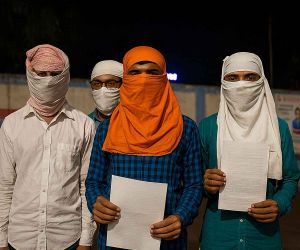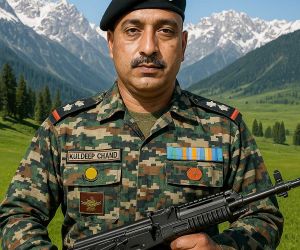MORE COVERAGE
Twitter Coverage
Satyaagrah
Written on
Satyaagrah
Written on
Satyaagrah
Written on
Satyaagrah
Written on
Satyaagrah
Written on
JOIN SATYAAGRAH SOCIAL MEDIA
As the Israel-Hamas war looms large, all eyes pivot to Hezbollah's potential influence, despite Israel's preference for peace, US takes no chances, bolstering its military presence to counteract Iran and its proxies, marking a tense geopolitical standoff

All Eyes on Hezbollah Amid Israel-Hamas Conflict: A Tense Middle Eastern Escalation
The Middle East stands at the precipice of a potential engulfing conflict. As Israeli Defence Forces tighten their grip around Gaza, military observers cast a wary eye towards Lebanon, wondering if the nation will intervene, escalating the conflict further. Tensions have already manifested in the form of border clashes, hinting at skirmishes that might spread along a second front. If the conflict gets prolonged, this localized battle might very well evolve into a regional catastrophe.
|
Hamas, in a desperate move to gain leverage, has resorted to threats of executing hostages. This not only highlights the extreme measures taken by the organization but also increases the risk of miscalculations, which could further exacerbate the situation.
However, a glimmer of hope remains as the violence, while intense, has been confined mainly along the Blue Line. This boundary, demarcated by the United Nations, separates Israel from southern Lebanon. Although there has been limited shelling and few incursions, the area has not seen the scale of violence that many had feared.
However, the question remains: Can this relative peace last? Recent intel suggests that anti-Israeli factions, including Hezbollah in Lebanon, Palestinian Islamic Jihad (PIJ), Hamas, and other Tehran-backed groups from regions such as Iraq, Yemen, and Syria, have been in covert discussions over the past six months. Their agenda? To heighten coordination and cooperation among themselves.
Given this backdrop, it seems unrealistic to expect Hezbollah to remain a silent spectator. As Israel intensifies its operations against Hamas in Gaza, many believe it's only a matter of time before Hezbollah, with its strong anti-Israel stance, steps in to support its allies.
|
Israel, known for its resilient defense capabilities, must navigate these complex geopolitical waters with caution and strategy. While its primary focus remains on neutralizing threats from Hamas, the looming shadow of Hezbollah and its allies could redefine the battlefield. This is not just a battle for territorial dominance; it's a fight for the very soul and future of the Middle East.
As the Israel-Hamas conflict continues to escalate, another formidable player casts a looming shadow over the battleground: Hezbollah. With Israel's offenses intensifying, there's mounting speculation about how and when Hezbollah might jump into the fray.
Given the current dynamics, it's becoming increasingly clear that Hezbollah cannot remain unaffected by Israel's moves. If tensions in Gaza rise further, there's a high probability that Hezbollah will ramp up its activities along the Blue Line, the fragile border separating Israel and Lebanon. The group might resort to its tried-and-tested ambush tactics against Israeli patrols or amplify its mortar and rocket attacks, particularly targeting the Shebaa Farms, a region under Israeli control since 1967.
Moreover, in a covert play, Hezbollah might launch rocket strikes into Israel without claiming responsibility, allowing the world to assume they are Hamas-led attacks. The group could also mobilize Tehran-backed militias to strike Israel from the Syrian Golan Heights, a region where Hezbollah retains influence.
At present, all signs suggest that Hezbollah's support to Hamas remains covert and calculated, aimed at avoiding a full-scale retaliation from Israel. It's a delicate dance, with each move being closely watched by the international community. If Hezbollah oversteps, the consequences could be dire, potentially leading to a spiraling cycle of violence.
|
Iran's role in this matrix cannot be understated. As a key ally of Hezbollah, Tehran seems to be exercising restraint, possibly limiting Hezbollah's operations to ensure they don't trigger an all-out war. For Iran, Hezbollah is a valuable asset, a last line of defense against potential Israeli or US attacks. Thus, Tehran is unlikely to risk Hezbollah's prowess in a localized conflict with Israel.
The Israeli perspective adds another layer to this intricate geopolitical puzzle. While Israel is primarily focused on rescuing hostages in Gaza and neutralizing remaining Hamas threats, it would prefer not to open up another front against Lebanon.
However, the dynamics could shift dramatically if Israel decides on a ground invasion. In such a scenario, Hezbollah, seeing its ally Hamas cornered, might be compelled to provide indirect support. This could include dispatching tactical advisors or launching diversionary rocket attacks to alleviate pressure on Hamas.
In essence, the Israel-Hamas conflict isn't just a two-player game. It's a multi-faceted chess match, with each move potentially altering the course of the Middle East's future. The question now is: how will these strategic plays unfold, and at what cost?
The ongoing Israel-Hamas conflict presents Israel with a series of complex strategic decisions, chief among them being the potential confrontation with Hezbollah. A full-blown simultaneous assault on both Gaza and Lebanon would undoubtedly stretch the Israeli Defence Forces (IDF) thin, even with their advanced technology and rigorous training. Such a move would be a monumental undertaking, fraught with risks.
|
While aerial strikes alone might hamper Hezbollah temporarily, they wouldn't significantly disrupt the group's operations. Without a sustained ground offensive accompanying these strikes, Hezbollah's leadership could quickly regroup and potentially mount a more coordinated counteroffensive. However, plunging deep into Lebanese territory with ground forces carries its own set of perils, including significant casualties. It's a tactical tightrope walk.
Moreover, a simultaneous offensive on both fronts would leave Israel vulnerable. If Hamas were to regroup and launch guerrilla-style attacks from unexpected quarters, the IDF would find itself battling on multiple fronts, a situation any military would want to avoid. This multi-pronged approach could also provoke other regional actors, leading to possible incursions from Syria, Iraq, and even Yemen, making the situation even more volatile.
Hezbollah's position is equally precarious. If Tehran pushes Hezbollah to go all-in supporting Hamas, it would demand a complete depletion of its military assets. Such a move might lead to a short-term tactical advantage, but the long-term implications for Lebanon would be devastating. A depleting of Hezbollah's arsenal would not only leave Lebanon vulnerable to external threats but could plunge the nation into an extended period of humanitarian crisis. Moreover, such a move could erode Hezbollah's local support, particularly among its core Shia base, as they witness the country's descent into chaos.
As tensions rise in the Middle East, the ongoing Israel-Hamas conflict has cast a shadow over the entire region, with many observers closely watching the potential flashpoint along the Lebanese-Israeli border. The situation seems like a powder keg, with any misstep capable of igniting a broader conflict.
|
Both parties, while formidable in their own right, appear to be treading cautiously. There is a tacit understanding that neither side truly desires an escalated, all-out conflict. Instead, a localized engagement between the two, primarily focused along the southern Lebanon and northern Israel corridors, seems to be the most likely outcome. But even this "limited" confrontation could prove volatile.
Hezbollah's potential deployment of its specialized Radwan Brigade to assist the Quds Force in cross-border skirmishes showcases its readiness for localized engagements. Such moves could prompt a response from the Israeli Air Force, targeting vital Lebanese infrastructure and potentially initiating limited armored incursions across the Blue Line.
In a bid to deter such Israeli actions, Hezbollah might unleash a barrage of missile attacks. Such a move would likely see the Israeli defence forces retaliating with precision-guided munitions targeting Hezbollah's launch pads. These aren't mere skirmishes; they're high-intensity engagements that could escalate rapidly if either side misjudges the other's intent or capabilities.
The IDF's potential pre-emptive strikes against known Hezbollah positions further complicate matters. By targeting Hezbollah's arsenals and neutralizing threats to its cities, Israel hopes to stay a step ahead. However, this proactive approach might be perceived as an act of aggression, provoking a more substantial response from Hezbollah.
The wildcard in this intricate game remains Hamas. Their unexpected assault on southern Israel has altered the region's strategic calculus. With Gaza now virtually encircled by Israeli forces and the IDF mobilizing reservists along the Southern Lebanon border, the stage is set for a potentially explosive confrontation.
In this high-stakes game of chess, where every move can have profound consequences, the hope is that cooler heads prevail. The alternative, a full-blown war, would undoubtedly have catastrophic implications for the entire Middle East. As the world watches with bated breath, the next moves by Israel and Hezbollah will shape the fate of the region.
|
Israel says not interested in war with Hezbollah
In the midst of rising tensions, Israel's stance on the northern front remains clear: it has no appetite for another war. Defence Minister Yoav Gallant reiterated this sentiment, emphasizing that Israel does not intend to amplify hostilities, especially with the ongoing conflict with Hamas in Gaza.
Recent sporadic fire across the Israel-Lebanon border has stoked fears that the current engagement with Hamas could evolve into a more extensive regional conflict. These anxieties were further exacerbated when, on a recent Sunday afternoon, alarms echoed across northern Israel as residents scrambled to safety. The military's interception of five out of nine rockets from Lebanon, followed by a retaliatory artillery strike, only heightened the sense of unease.
However, amidst this backdrop of escalating tensions, Minister Gallant's message remained unequivocal. "We have no interest in a war in the north," he asserted, signaling Israel's preference for de-escalation and stability. This commitment to restraint, however, comes with a caveat. Should Hezbollah opt for aggression, Israel's response will be decisive. "If Hezbollah chooses the path of war, it will pay a very heavy price," warned Gallant. But, he also pointed out, should Hezbollah choose restraint, Israel would reciprocate in kind.
Gallant's statements during his visit to troops in southern Israel underscored the nation's stance. It's a delicate balance between upholding national security and avoiding unnecessary conflict, especially when faced with provocations. While Israel remains prepared to defend its borders, its primary objective, at least on the northern front, seems to be one of maintaining peace.
Such a position resonates with the broader desire for stability in a region already beset by numerous challenges. As Defence Minister Gallant aptly summarized, while Israel remains prepared to defend itself, it hopes for a scenario where restraint prevails on both sides. Only time will tell if this call for calm resonates across the border.
|
US Sends Warships, Over 100 Jets to Middle East to Stop Iran, Hezbollah from Joining Israel-Gaza War
In an assertive display of strength and support, the United States is significantly bolstering its military presence in the Middle East. Amid the escalating Israel-Hamas conflict, there's a growing concern about the potential involvement of regional players like Iran, Syria, and proxy groups backed by Iran, including Hezbollah. The U.S. move is seen as a decisive step to deter these actors from deepening the crisis.
U.S. Defense Secretary Lloyd J. Austin III has taken the robust step of dispatching another aircraft carrier, the Dwight D. Eisenhower, to the eastern Mediterranean sea. According to the New York Times, this strategic maneuver aims to ensure that there are no "hostile actions against Israel or any efforts toward widening this war". This carrier is expected to join the existing fleet in a matter of days.
|
The underlying objective of this American military augmentation is clear: to deter and prevent any involvement by Iran or its affiliated groups in the ongoing 2023 Israel-Hamas conflict. This stance comes amid rising apprehensions among American commanders about the U.S. being inadvertently dragged into the fray.
Further amplifying its commitment, the U.S. Air Force is deploying more land-based attack planes to the Persian Gulf region. This will result in an increased number of F-16, A-10, and F-15E squadrons on the ground. Collectively, these actions will establish a formidable U.S. aerial armada in the region, consisting of around 100 fighter aircraft.
|
Adding another layer to the U.S.'s comprehensive approach, a specialized team of Special Operations forces is being dispatched to Israel. Their primary mission is to aid in intelligence gathering and planning for potential operations aimed at locating and rescuing the 150 hostages held by Hamas inside the Gaza Strip. Notably, among these hostages are American citizens, which adds a direct U.S. stake in the crisis.
The U.S.'s decisive military posturing in the region is a clear message: it stands by its allies and is prepared to take concrete steps to ensure regional stability and prevent the conflict from spiraling into a wider regional war.
Notably, the U.S. is intensifying its monitoring of Hezbollah forces in Lebanon and Iran-backed militias in Iraq and Syria, given their history of launching missile strikes against U.S. personnel in these nations.
This vigilance is warranted. As recently as March, a U.S. civilian contractor was tragically killed, with six other Americans injured, in northeast Syria by a drone suspected to be of Iranian origin. President Biden's administration swiftly retaliated with airstrikes targeting terrorist bases associated with the Iranian Islamic Revolutionary Guards Corps (IRGC). This action, however, elicited a counter-response from Iran-backed terrorist groups, resulting in the wounding of another American.
In this volatile scenario, President Biden has made it clear that the U.S. stands firmly with Israel. He aims to signal not only solidarity with Israel but also to convey a strong message of deterrence to Hamas and other hostile entities in the region. U.S. Defence Secretary Lloyd J. Austin III reinforced this stance, emphasizing the U.S.'s objective to equip Israel with the necessary resources to safeguard its security. The U.S. is ensuring that the Israel Defence Forces (IDF) has access to advanced weaponry, including interceptors for its Iron Dome missile defense system and precision "small-diameter bombs" crafted to minimize civilian casualties, especially vital given the dense population of areas like Gaza City.
|
The strategic deployment of the aircraft carrier Gerald R. Ford to the Mediterranean sea's eastern side, closer to Israel, is another testament to the U.S.'s proactive approach. This carrier, brimming with four F/A-18 Super Hornet fighter squadrons and equipped for electronic warfare and command and control, amplifies the U.S.'s naval might in the region. Coupled with the Dwight D. Eisenhower's similar capabilities, the U.S.'s naval presence in the region is now formidable.
In conclusion, the U.S.'s decisive military deployments and strategic decisions are not just reactive measures. They are clear indicators of its commitment to maintaining stability in West Asia, supporting its allies, and deterring adversaries from broadening the conflict. As tensions rise, the U.S. is leaving no stone unturned in ensuring the safety of its personnel and its allies in the region.
 Support Us
Support Us
Satyagraha was born from the heart of our land, with an undying aim to unveil the true essence of Bharat. It seeks to illuminate the hidden tales of our valiant freedom fighters and the rich chronicles that haven't yet sung their complete melody in the mainstream.
While platforms like NDTV and 'The Wire' effortlessly garner funds under the banner of safeguarding democracy, we at Satyagraha walk a different path. Our strength and resonance come from you. In this journey to weave a stronger Bharat, every little contribution amplifies our voice. Let's come together, contribute as you can, and champion the true spirit of our nation.
 |  |  |
| ICICI Bank of Satyaagrah | Razorpay Bank of Satyaagrah | PayPal Bank of Satyaagrah - For International Payments |
If all above doesn't work, then try the LINK below:
Please share the article on other platforms
DISCLAIMER: The author is solely responsible for the views expressed in this article. The author carries the responsibility for citing and/or licensing of images utilized within the text. The website also frequently uses non-commercial images for representational purposes only in line with the article. We are not responsible for the authenticity of such images. If some images have a copyright issue, we request the person/entity to contact us at satyaagrahindia@gmail.com and we will take the necessary actions to resolve the issue.
Related Articles
- "War unchosen, the outcome unforeseen; Israel stands firm": Iran-backed Houthis in Yemen escalate conflict by declaring war on Israel, launching missiles and drones at Eilat, prompting a robust response from the IDF with advanced interception technology
- "भाग भाग डीके बोस": After Israel’s airstrike eliminated Hezbollah chief Hassan Nasrallah, Iran’s Supreme Leader Ayatollah Khamenei went into hiding, as Operation New Order decimated Hezbollah’s leadership and missile arsenal with bunker buster bombs
- "Nefarious Design Unearthed": Israeli President Isaac Herzog claims that it was Iran who orchestrated Oct 7 Hamas attacks to derail India-Middle East-Europe Economic Corridor as it is paving the way for Israel's inclusion in the region and peace process
- "Mohammad Deif, Hamas terror architect": Unveiling the mastermind behind the deadly 'Al Aqsa Storm' operation into Israel, his extensive history of orchestrating attacks, along with Israel's decisive actions and countermeasures against Hamas terrorism
- "Behind every shield, a heart still beats": As the Hamas-Israel conflict intensifies, innocent Israeli babies confront horrors beyond imagination, amidst fragile diplomatic efforts, these souls are caught in a war's crossfire, bearing heart-wrenching toll
- "Starving with every breath, yet waging war unto death": War-ravaged Yemen, where millions of Muslims face starvation, the Houthis choose war, firing missiles over 1000 miles to support Hamas against Israel, sidelining nation's humanitarian catastrophe
- "Securing Lives, Challenging Terror": Israel nears a strategic breakthrough with Hamas, negotiating the release of hostages in a move that underscores its resolve and commitment to its people amid a tense, decades-long conflict in the Middle East
- "World Must Witness Truth": Israel screens 44-min unedited raw footage of Hamas' Oct 7 massacre, revealing confessions of targeting Jews and incentives for abducting women and children, the video aims to counter Hamas 'denial of the chilling atrocities'
- "Mecca's Resolve: Preserving Purity" - Saudi Arabia escalates its crackdown in Mecca and Medina, escorting Muslims to off-site locations; they're interrogated for activism about Palestine and Gaza, starkly portraying the cost of activism in sacred spaces
- "Hamas rockets: missing Israel, finding Gaza": Evidence mounts towards a tragic revelation, Hamas in an alarming misjudgment, had inadvertently launched a rocket that grievously impacted Gaza's very own Al-Ahli al-Arabi Hospital, inflicting its own people
- "Foul Zenith": In a chilling strategy, Hamas holds Gaza captive, using residents as shields, as the conflict rages, 50000 pregnant women put forth for emotional leverage; meanwhile leaked plans unveil Hamas's intent to maximize innocent Israeli casualties
- Publishing house The Hindu, in its English magazine 'FrontLine' officially endorsed Hamas violence, justifying brutal acts of terrorism as victimhood, this stance potentially lays the groundwork for future genocides in the name of vengeful holy war
- "Shattered Peace": In a harrowing incident, a French school witnesses horror as a lad shouting #AllahuAkbar takes life of a teacher & injures many, attack aligns with Hamas call for 'Global Day of Jihad', France grapples with terror amidst rising tensions
- ‘Execute Hamas terrorists including my father, no exceptions’: Son of Hamas terrorist asks Israel to not go easy on Hamas with negotiations, says Hamas is waging psychological warfare, using children, infants, human shields, still playing the victim card
- In the alarming aftermath of Oct 7th attack, Israel uncovers Hamas terrorists carrying cyanide bomb directives, as a decisive countermeasure, the nation launches 'Nili' unit, staunchly committed to tracking and neutralizing the culprits behind such terror

























